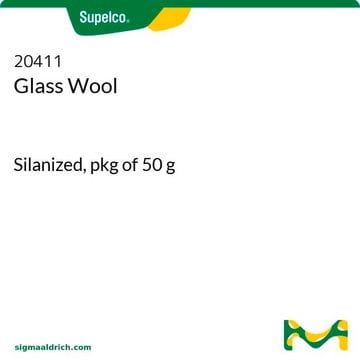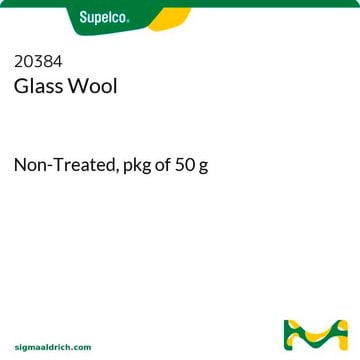About This Item
Recommended Products
Agency
suitable for EPA 1613
Quality Level
impurities
≤0.005% Heavy metals (as Pb)
≤0.1% Alcali soluble in water (as Na2O)
≤1% Substances soluble in hydrochloric acid
pH
9-11 (20 °C, 100 g/L in H2O, slurry)
bulk density
20‑160 kg/m3
storage temp.
no temp limit
InChI
1S/Ca.Na.H3O4P/c;;1-5(2,3)4/h;;(H3,1,2,3,4)/q+2;+1;/p-3
InChI key
QXJJQWWVWRCVQT-UHFFFAOYSA-K
Related Categories
General description
Glass wool plugs are often used in GC inlet liners to improve sample vaporization and to keep non-volatile material from entering the column. They can also be used in packed GC columns, solvent desorption tubes, thermal desorption tubes, and purge traps to retain adsorbent beds.
Application
- Assessment of different factors on the influence of glass wool concentration for detection of main swine viruses in water samples: This research demonstrates the use of glass wool in the filtration and concentration of viruses from environmental samples, contributing significantly to public health safety and environmental monitoring (Fan et al., 2023).
- The Evolution of Insulation Performance of Fiber-Reinforced Silica Aerogel after High-Temperature Treatment: Research on glass wool′s effectiveness in thermal insulation and its durability under high temperatures is essential for its application in high-performance building envelopes and industrial installations (Gao et al., 2023).
Analysis Note
Alcali soluble in water (as Na₂O): ≤ 0.1 %
Heavy metals (as Pb): ≤ 0.005 %
Diameter of fibre (15-25 µm): passes test
Storage Class Code
13 - Non Combustible Solids
WGK
WGK 1
Flash Point(F)
Not applicable
Flash Point(C)
Not applicable
Certificates of Analysis (COA)
Search for Certificates of Analysis (COA) by entering the products Lot/Batch Number. Lot and Batch Numbers can be found on a product’s label following the words ‘Lot’ or ‘Batch’.
Already Own This Product?
Find documentation for the products that you have recently purchased in the Document Library.
Customers Also Viewed
Related Content
This page is intended to make it easier to find the consumables you need based on the analytical method you’re using. Methods included on this page come from the EPA, Standard Methods and ASTM.
Our team of scientists has experience in all areas of research including Life Science, Material Science, Chemical Synthesis, Chromatography, Analytical and many others.
Contact Technical Service






